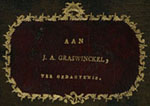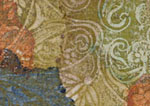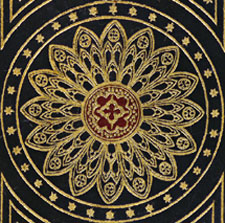Bookbindings of the Koninklijke Bibliotheek (KB), The National library of the Netherlands > Bookbindings
Nowadays, when buying books, the binding is taken for granted. The binding, the book's appearance, is the same for the entire print run and is determined by the publisher together with a graphic designer. In the past this was different.
Binding loose pages
Prior to around 1830, texts were bought as loose pages, sometimes folded into a quire and given a temporary cover. The first owner then had a bookbinder put a final cover on it. The collated quires were sewn by the binder, who then attached this book block to the boards and the spine. These were then covered, usually with leather or parchment. It is, therefore, possible to find the same text with different bindings.
In 1781, Hieronymus van Alphen married Catherina Geertruida van Valkenburg. In keeping with the 18th century tradition an "egtzang" (wedding poem) was composed for the occasion. In this case it was composed by Van Alphen himself. The bridegroom had a few copies of the text bound in green leather, decorated with gold, and handed them out to important guests. He had their names put on the covers. M.T.C.C. van Ossenbergh, a family member, also received a copy, but in this case bound in decorated paper: he was clearly a less important guest.
A special appearance for special occasions
So, apart from the traditional purpose of bookbinding, namely, protection of the text, the binding is also a means of giving individual copies of a particular text a unique appearance. For special occasions, or if appearance of the book was of particular importance to the client/owner, the binding was decorated with ornaments in gold leaf and possibly fitted with expensive clasps, to fit in with the wishes of the client. In addition, special materials or techniques were used on these bindings.
Decoration
Bookbindings were, not taking into account the magnificent bindings from the Middle Ages that were adorned with gold and gems, decorated using stamps or blocks. A decorative pattern was achieved by pressing individual brass stamps by hand. A press was sometimes used to print the larger, flat plate blocks. Stamping with the help of gold leaf was introduced in Europe during the Renaissance. Also pieces of leather in other colors were applied to the bindings. In the course of the next centuries, bookbinding followed the same development trends as the other arts. France usually appeared to be authoritative and the decoration on bookbindings coincided with the patterns found in silver work and the textile and furniture arts.
New possibilities
After 1830, with the aid of new machinery and materials, it became possible to give books a uniform appearance. With the introduction of binding cloth and the improvement of the necessary presses, a large number of books could quickly be given the same binding. The hand-bound books did not, however, disappear, but became an expensive luxury item. This development led to a marginal position for the trade, particularly in the Netherlands, with book designers and artists drawing attention to this on several occasions. "A book is not truly finished until it has been bound" wrote Jan van Krimpen in 1924. In contrast to elsewhere, the circle of wealthy buffs in the Netherlands was very small and there were limited training possibilities. It nevertheless proved possible to preserve the trade and even to this day there are a number of binders who manifest themselves internationally.




